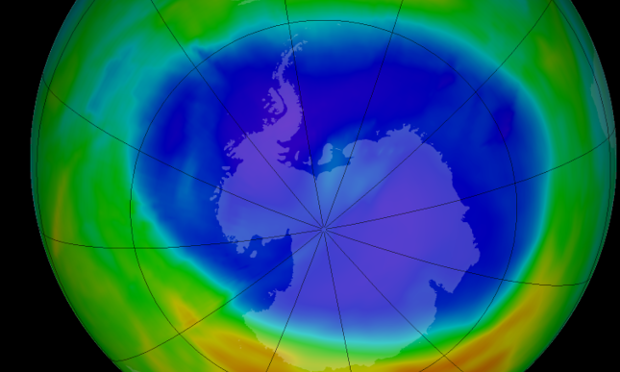 The Obama administration will unveil new limits on smog pollution bringing the US up to par with public health standards in other industrialised countries.
The Obama administration will unveil new limits on smog pollution bringing the US up to par with public health standards in other industrialised countries.
The Environmental Protection Agency is under a court-ordered deadline to propose new rules for ground-level ozone by 1 December. The New York Times reported that the announcement would come on Wednesday.
The new standards represent a victory for public health and environment groups which had sued the Obama administration for rejecting stricter controls for political reasons.
Obama to unveil new limits on ozone pollution in victory for health groups
Fracking: The Downside of the Boom
 In early August 2013, Arlene Skurupey of Blacksburg, Va., got an animated call from the normally taciturn farmer who rents her family land in Billings County, N.D. There had been an accident at the Skurupey 1-9H oil well. “Oh, my gosh, the gold is blowing,” she said he told her. “Bakken gold.”
In early August 2013, Arlene Skurupey of Blacksburg, Va., got an animated call from the normally taciturn farmer who rents her family land in Billings County, N.D. There had been an accident at the Skurupey 1-9H oil well. “Oh, my gosh, the gold is blowing,” she said he told her. “Bakken gold.”
It was the 11th blowout since 2006 at a North Dakota well operated by Continental Resources, the most prolific producer in the booming Bakken oil patch. Spewing some 173,250 gallons of potential pollutants, the eruption, undisclosed at the time, was serious enough to bring the Oklahoma-based company’s chairman and chief executive, Harold G. Hamm, to the remote scene.
UN: World not close to avoiding dangerous warming
The world still isn't close to preventing what leaders call a dangerous level of man-made warming, a new United Nations report says. That's despite some nations' recent pledges to cut back on carbon dioxide emissions.
The report looks at the gap between what countries promise to do about carbon pollution and what scientists say needs to be done to prevent temperatures rising another two degrees. That two-degree level is a goal that world leaders set in 2009.
Are Fracking Workers Being Poisoned on the Job?
 Last week’s Republican election victories will set the stage for more stagnation in Washington, but might also grease the skids for some of the most controversial energy ventures at ground zero in the climate change debate: the long-stalled Keystone XL Pipeline project, and the booming hydraulic fracturing, or "fracking," industry. But one thing that might put the brakes on the dirty fuel rush is the mounting research evidence linking oil and gas extraction to massive health risks for workers and communities.
Last week’s Republican election victories will set the stage for more stagnation in Washington, but might also grease the skids for some of the most controversial energy ventures at ground zero in the climate change debate: the long-stalled Keystone XL Pipeline project, and the booming hydraulic fracturing, or "fracking," industry. But one thing that might put the brakes on the dirty fuel rush is the mounting research evidence linking oil and gas extraction to massive health risks for workers and communities.
A new study published in Environmental Health reveals air pollution data on major, in some cases previously underestimated, health risks from toxic contamination at gas production sites related to fracking.
Capping warming at 2 C not enough to avert disaster, climate experts warn
 Scientists, environmentalists and world leaders alike have generally agreed that capping Earth’s temperature rise at 2 degrees Celsius would prevent the worst effects of climate change — a cut-off touted again in the latest report by the Intergovernmental Panel on Climate Change (IPCC).
Scientists, environmentalists and world leaders alike have generally agreed that capping Earth’s temperature rise at 2 degrees Celsius would prevent the worst effects of climate change — a cut-off touted again in the latest report by the Intergovernmental Panel on Climate Change (IPCC).
But many experts in the field, including former IPCC leaders, have said that even if global warming is kept to that limit, such a rise could nevertheless devastate the environment and endanger humanity — the very effects that the latest study warns will happen if the 2 C ceiling is breached.
The Climate-Change Solution No One Will Talk About
 The equation seems fairly simple: The more the world's population rises, the greater the strain on dwindling resources and the greater the impact on the environment.
The equation seems fairly simple: The more the world's population rises, the greater the strain on dwindling resources and the greater the impact on the environment.
The solution? Well, that's a little trickier to talk about.
Public-health discussions will regularly include mentions of voluntary family planning as a way to reduce unwanted pregnancies and births. But, said Jason Bremner of the Population Reference Bureau, those policies can also pay dividends for the environment.
"And yet the climate-change benefits of family planning have been largely absent from any climate-change or family-planning policy discussions," he said.
Ozone hole remains size of North America, Nasa data shows
 The Antarctic ozone hole, which was expected to reduce in size swiftly when manmade chlorine emissions were outlawed 27 years ago, is stubbornly remaining the size of North America, new data from Nasa suggests.
The Antarctic ozone hole, which was expected to reduce in size swiftly when manmade chlorine emissions were outlawed 27 years ago, is stubbornly remaining the size of North America, new data from Nasa suggests.
The hole in the thin layer of gas, which helps shield life on Earth from potentially harmful ultraviolet solar radiation that can cause skin cancers, grows and contracts throughout the year but reached its maximum extent on 9 September when monitors at the south pole showed it to cover 24.1m square km (9.3m sq miles). This is about 9% below the record maximum in 2000 but almost the same as in 2010, 2012 and 2013.
Hundreds of thousands of gallons of oil from BP spill may be on the ocean floor
 Over 5 million barrels of oil was released into the ocean during the BP Deepwater Horizon oil spill, and up to 620,000 barrels may now be on the ocean floor, a new study finds.
Over 5 million barrels of oil was released into the ocean during the BP Deepwater Horizon oil spill, and up to 620,000 barrels may now be on the ocean floor, a new study finds.
The study, done by geochemists at the University of California, Santa Barbara, looked at sediment samples from the Gulf of Mexico and located evidence of the chemical Hopane, which indicates the presence of crude oil. It was known that 2 million barrels of the 5 million barrels spilled had not been collected, and the researchers determined between 4 and 31 percent of the 2 million barrels has reached the ocean floor.
Colombian farmers sue BP for $29M over alleged land degredation
 Colombian farmers took on oil giant BP in the British High Court on Wednesday, in a lawsuit that alleges that the company negligently managed the construction of a pipeline in the mid-1990s, resulting in severe damage to their land.
Colombian farmers took on oil giant BP in the British High Court on Wednesday, in a lawsuit that alleges that the company negligently managed the construction of a pipeline in the mid-1990s, resulting in severe damage to their land.
The four-month trial marks the first time the U.K. firm has faced a domestic court over its actions overseas in what is being billed as one of the largest environmental case of its kind.
More Articles...
Page 27 of 156

 Environmental News Archive
Environmental News Archive


































